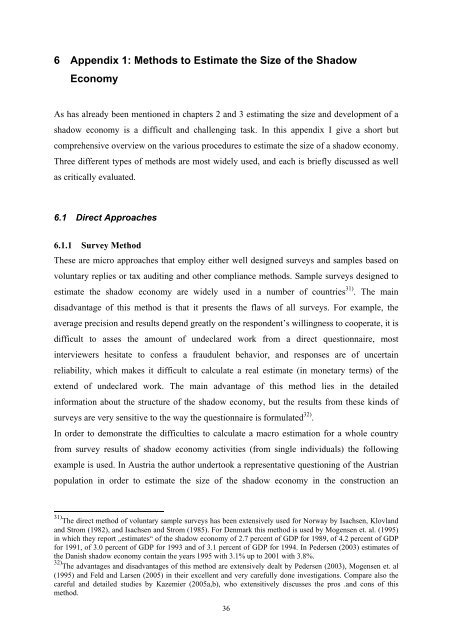Shadow Economies and Corruption All Over the World - Index of - IZA
Shadow Economies and Corruption All Over the World - Index of - IZA
Shadow Economies and Corruption All Over the World - Index of - IZA
You also want an ePaper? Increase the reach of your titles
YUMPU automatically turns print PDFs into web optimized ePapers that Google loves.
6 Appendix 1: Methods to Estimate <strong>the</strong> Size <strong>of</strong> <strong>the</strong> <strong>Shadow</strong><br />
Economy<br />
As has already been mentioned in chapters 2 <strong>and</strong> 3 estimating <strong>the</strong> size <strong>and</strong> development <strong>of</strong> a<br />
shadow economy is a difficult <strong>and</strong> challenging task. In this appendix I give a short but<br />
comprehensive overview on <strong>the</strong> various procedures to estimate <strong>the</strong> size <strong>of</strong> a shadow economy.<br />
Three different types <strong>of</strong> methods are most widely used, <strong>and</strong> each is briefly discussed as well<br />
as critically evaluated.<br />
6.1 Direct Approaches<br />
6.1.1 Survey Method<br />
These are micro approaches that employ ei<strong>the</strong>r well designed surveys <strong>and</strong> samples based on<br />
voluntary replies or tax auditing <strong>and</strong> o<strong>the</strong>r compliance methods. Sample surveys designed to<br />
estimate <strong>the</strong> shadow economy are widely used in a number <strong>of</strong> countries 31) . The main<br />
disadvantage <strong>of</strong> this method is that it presents <strong>the</strong> flaws <strong>of</strong> all surveys. For example, <strong>the</strong><br />
average precision <strong>and</strong> results depend greatly on <strong>the</strong> respondent’s willingness to cooperate, it is<br />
difficult to asses <strong>the</strong> amount <strong>of</strong> undeclared work from a direct questionnaire, most<br />
interviewers hesitate to confess a fraudulent behavior, <strong>and</strong> responses are <strong>of</strong> uncertain<br />
reliability, which makes it difficult to calculate a real estimate (in monetary terms) <strong>of</strong> <strong>the</strong><br />
extend <strong>of</strong> undeclared work. The main advantage <strong>of</strong> this method lies in <strong>the</strong> detailed<br />
information about <strong>the</strong> structure <strong>of</strong> <strong>the</strong> shadow economy, but <strong>the</strong> results from <strong>the</strong>se kinds <strong>of</strong><br />
surveys are very sensitive to <strong>the</strong> way <strong>the</strong> questionnaire is formulated 32) .<br />
In order to demonstrate <strong>the</strong> difficulties to calculate a macro estimation for a whole country<br />
from survey results <strong>of</strong> shadow economy activities (from single individuals) <strong>the</strong> following<br />
example is used. In Austria <strong>the</strong> author undertook a representative questioning <strong>of</strong> <strong>the</strong> Austrian<br />
population in order to estimate <strong>the</strong> size <strong>of</strong> <strong>the</strong> shadow economy in <strong>the</strong> construction an<br />
31) The direct method <strong>of</strong> voluntary sample surveys has been extensively used for Norway by Isachsen, Klovl<strong>and</strong><br />
<strong>and</strong> Strom (1982), <strong>and</strong> Isachsen <strong>and</strong> Strom (1985). For Denmark this method is used by Mogensen et. al. (1995)<br />
in which <strong>the</strong>y report „estimates“ <strong>of</strong> <strong>the</strong> shadow economy <strong>of</strong> 2.7 percent <strong>of</strong> GDP for 1989, <strong>of</strong> 4.2 percent <strong>of</strong> GDP<br />
for 1991, <strong>of</strong> 3.0 percent <strong>of</strong> GDP for 1993 <strong>and</strong> <strong>of</strong> 3.1 percent <strong>of</strong> GDP for 1994. In Pedersen (2003) estimates <strong>of</strong><br />
<strong>the</strong> Danish shadow economy contain <strong>the</strong> years 1995 with 3.1% up to 2001 with 3.8%.<br />
32) The advantages <strong>and</strong> disadvantages <strong>of</strong> this method are extensively dealt by Pedersen (2003), Mogensen et. al<br />
(1995) <strong>and</strong> Feld <strong>and</strong> Larsen (2005) in <strong>the</strong>ir excellent <strong>and</strong> very carefully done investigations. Compare also <strong>the</strong><br />
careful <strong>and</strong> detailed studies by Kazemier (2005a,b), who extensitively discusses <strong>the</strong> pros .<strong>and</strong> cons <strong>of</strong> this<br />
method.<br />
36
















